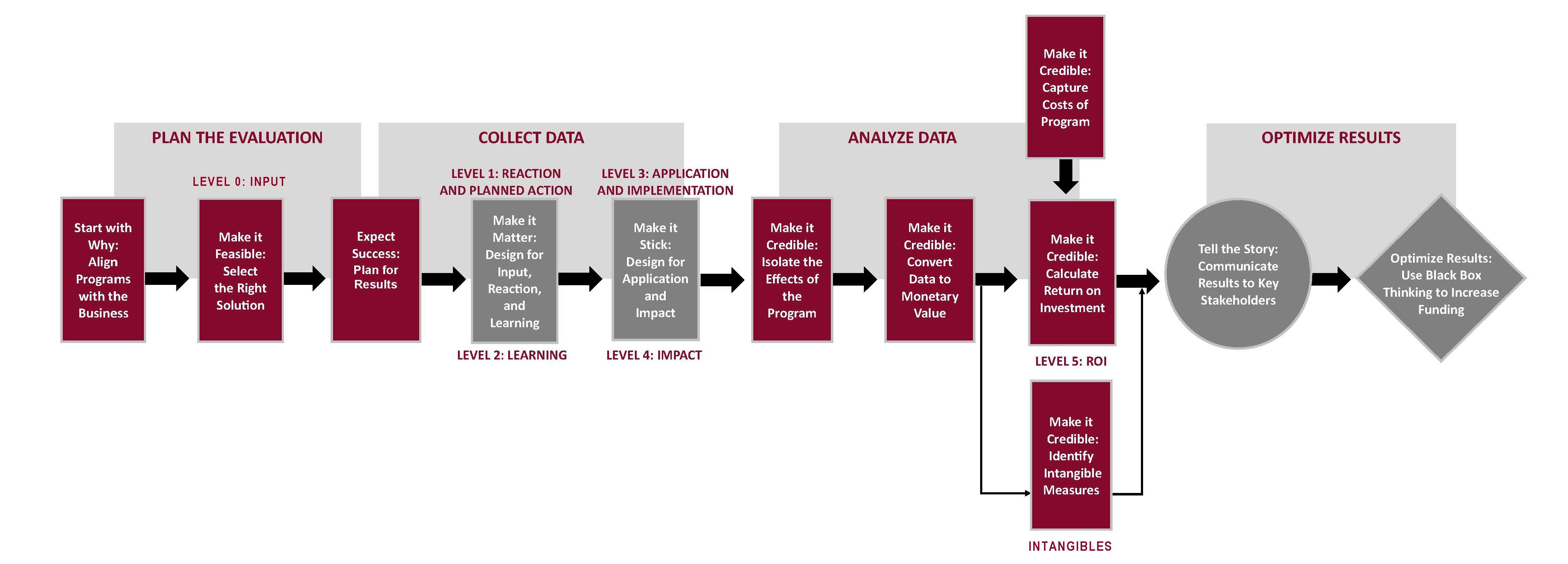Your cart is currently empty!
Proceedings of Coaching and Mentoring Congress 2020: Responsibility and Limits in Coaching and Mentoring
Using Design Thinking to Deliver Business Results from Coaching
By Patti P. Phillips, Ph.D., Jack J. Phillips, Ph.D., and Melissa Brown, M.S.
Resulting from the COVID-19 crisis, many economists and business executives predict a recession—affecting the global economy for the remainder of 2020 and into 2021. Consequently, organizational leaders will conduct comprehensive reviews of projects in an attempt to cut budgets and save money. Coaches across all functions must be prepared to demonstrate how coaching projects drive the business in the post-pandemic world. Taking a proactive approach now by following a 12-step process built on design thinking principles can safeguard budgets during and after this time of uncertainty.
The Challenge
Although many changes have occurred in the coaching profession in recent years, a key question remains: should the success of coaching be measured; and if so, how? Executives recognize that coaching is important to meet the challenges of a complex and global economy, especially during a time of crisis. Individuals recognize that coaching positively impacts their life when goals and dreams are realized. Unfortunately, there are persistent concerns within the coaching community about how and when coaching should be evaluated—particularly at the impact and ROI level. Coaching is an absolute necessity and can greatly add value to an organization’s bottom line. Using a methodical, multi-step, results-driven process based on design thinking, the investment in coaching can be enhanced.
Apart from the COVID-19 crisis, coaches recognize the need to show value. According to an ICF survey, 60% of professional coaches indicated that the biggest obstacle they face in building a successful practice is sales/business development. With constant growth of coaches, credible business value delivered is the best way to stand out in the crowded field of coaching.
The fact that executives & CFOs want to see the monetary value of coaching programs is acknowledged by coach practitioners with 26% indicating that they need credible ROI data. Another 38% see increased awareness of coaching benefits as a future opportunity.
The ROI Methodology
The ROI Methodology® is the most recognized approach to ROI evaluation. This methodology is implemented in more than half of the Fortune 500 companies, as well as several other private and government organizations throughout the United States and in more than 70 countries. The ROI Methodology provides organizations a process that can cross organizational boundaries, linking programs, processes, and initiatives to bottom-line measures.
The ROI Methodology has sustained its position as the leading evaluation approach because it:
- Reports a balanced set of measures.
- Follows a methodical, step-by-step process.
- Adheres to standards and philosophy of maintaining a conservative approach and credible outcomes.
A Balanced Set of Measures
The concepts of cost-benefit analysis and ROI have been used to show the value of programs, processes, and initiatives for centuries. Cost-benefit analysis is grounded in welfare economics and public finance; ROI in business accounting and finance. Together, the two are the ultimate measures of the contribution of programs, processes, and initiatives. However, alone, they are insufficient. While cost-benefit analysis and ROI report the financial success of programs, they omit critical evidence as to why the financial impact is as it is. By balancing financial impact with measures that address individuals’ perspectives and the systems and processes that support application, a complete story of program success can be presented.
The ROI Methodology categorizes evaluation data into five levels:
- Reaction and Planned Action
- Learning
- Application and Implementation
- Impact
- Return on Investment (ROI)
Process Model
The ROI process integrates design thinking principles into four process stages to ensure the appropriate data are collected from the proper sources at the right time. The process consists of sequential, logical steps that lead to data categorized by the five levels of outcome data, using design thinking principles to deliver business results. The process of evaluating a program begins with asking why, then aligning programs to business needs, and concluding with optimizing the results.
Rooted in innovation, design thinking suggests that goals should be set for the desired outcome and the entire team should be mobilized to design the product, service, or process to achieve the goals. More specifically, design thinking involves these elements:
- Method to take on design challenges by applying empathy
- Approach to collective problem solving
- Framework to balance needs and feasibility
- Process to solve complex or wicked problems
- Aptitude for curiosity and inquiry
- Problem-solving approach to handle problems on a systems level
- Culture that fosters exploration and experimentation
Relating this process to coaching means that all stakeholders should work in a collaborative way to design for the desired results from coaching. The results desired could be one or all of these levels of outcomes: Reaction, Learning, Application, Impact, and possibly ROI. These outcomes represent a logical flow of data from a classic logic model. In today’s tough economic climate, the desired level of results is impact, expressed as improvements in output, quality, time, and costs.
This can be accomplished by following 12 steps, as shown in Figure 1, to design for the needed business impact.
Figure 1. The ROI Methodology Process

- Start with Why: Align programs with specific business
- Make It Feasible: Select the right solution to drive the business
- Expect Success: Design for business results. Objectives are set to push accountability to the business impact level, with reaction, learning, application, and impact objectives. Designers, developers, coaches, participants and managers of participants know what they must do to deliver business
- Make It Matter: Design for Reaction and Learning, ensuring that the content is important, meaningful, and actionable, setting the stage to drive business
- Make It Stick: Design for Application and Impact, ensuring that a participant is using the learning (Application) and that it has an impact. Results are measured at both Application and Impact levels and barriers must be removed or
- Make it Credible: Isolate the effects of the program. With impact data in hand, the results must be credible. This step isolates the effects of the program on the impact data.
- Make it Credible: Convert data to monetary value. The impact data is converted to money.
- Make it Credible: Capture costs of program. This includes direct and indirect costs.
- Make it Credible: Calculate the ROI. The monetary benefits are compared to the cost of the program in an ROI calculation. The financial ROI is calculated the same way that a CFO would calculate a capital investment. Note: evaluation at this level is pursued very selectively, usually involving about 10% of coaching programs each year. 3
- Make it Credible: Identify the intangible benefits. The impact data not converted to money are identified and connected to the program.
- Tell the Story: Communicate results to key stakeholders–Reaction, learning, application, impact, and perhaps even ROI data, form the basis for a powerful
- Optimize Results: Use black box thinking to increase funding. Designing for results usually drives the needed results, but there’s always an opportunity to make the results even better. Process improvements increase ROI in the future. Increased ROI makes a great case for more
Using this process almost guarantees the desired business results, because you have been intentional in the design process.
Scope and Use
The methodology had its beginnings in the learning and development area and quickly permeated into other applications such as human resources, marketing, quality, IT, and coaching. The process has also expanded to all types of projects and programs in a variety of organizations including nonprofits, NGOs, and the public sector. The process has been fully implemented in more than 70 countries.
This process captures a balanced set of data. It is systematic, user-friendly, and brings business evaluation to major programs. The process is supported by a tremendous amount of research with practical usage and application. It is estimated that 3,000-5,000 studies are conducted each year. The conservative standards make it executive-friendly. The ROI Methodology has become the most documented evaluation system in the world with books in 38 languages and case books developed in at least a dozen countries.
Influencing the Budget
Implementing this approach, four significant principles emerge. First, process improvement permeates the eight steps. If the desired results are not attained, adjustments are made at steps four, five, and six to ensure that the results are delivered in the next attempt. Secondly, limit the number of programs that are evaluated all the way to ROI, illustrating to executives that coaching is a worthy investment. The third principle emphasizes that top executives now perceive coaching as an investment; leading to funding being improved instead of eliminated. Evaluation leads to optimization, which leads to allocation of funding.4

The fourth principle states that you can assist in the decision-making process when your funders of coaching decide how to invest their money. If coaching is delivering a positive return, suggest executives invest more. It’s a logical argument and one that can transform not only the budget for coaching, but also the support and influence desired.
The Payoff
The payoffs of the ROI Methodology are numerous, as listed in Figure 2. This approach satisfies the desire to have a credible process and shows the contribution of important programs. Four important reasons are: to improve programs (process improvement versus performance evaluation for the program team is critical), gain support for the programs, build relationships with key executives and administrators (who often fund the programs) and provide funding for programs in the future.
Figure 2. ROI Methodology: The Payoff
- Align projects to business needs
- Show contributions of selected projects
- Earn respect of senior management/administrators
- Build staff morale
- Justify/defend budgets
- Improve support for projects
- Enhance design and implementation processes
- Identify inefficient projects that need to be redesigned or eliminated
- Identify successful projects that can be implemented in other areas
- Earn a “seat at the table”
The ultimate measure of success of a coaching program, process, or initiative is ROI. Following these principles and implementing design thinking will reap rewards for your bottomline. You will then be able to measure and evaluate the impact and ROI, using the ROI Methodology.
References
- Phillips, Jack J. and Patti P. Phillips. Measuring for Success: What CEOs Really Think about Learning Investments. Alexandria, VA: ASTD Press. 2010.
- Mootee, Idris. Design Thinking for Strategic Innovation. Hoboken, NJ: 2013.
- Phillips, Patti P. and Jack J. Phillips. Measuring the Success of Coaching: A Step-by-Step Guide for Measuring Impact and Calculating ROI. Alexandria, VA: ASTD 2012.
- Phillips, Patti P. and Jack J. Phillips. The Business Case for Learning: Using Design Thinking to Deliver Business Results and Increase the Investment in Talent West Chester, PA and Alexandria, VA: HRDQ and ATD Press. 2017.
About the Authors
Dr. Jack Phillips, world-renowned expert on measurement and evaluation, is chairman of the ROI Institute. Dr. Patti Phillips, CEO of ROI Institute, works as an educator, researcher, consultant, and coach to support practitioners worldwide develop their own evaluation expertise. In 2019, both were recognized as two of the Top 50 World Leaders in Coaching and were finalists for the Marshall Goldsmith Distinguished Achievement Award in Coaching. Melissa Brown, director of partnerships at ROI Institute, manages special projects and global communication.


























